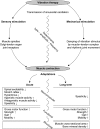Vibration therapy in patients with cerebral palsy: a systematic review
- PMID: 29950843
- PMCID: PMC6018484
- DOI: 10.2147/NDT.S152543
Vibration therapy in patients with cerebral palsy: a systematic review
Abstract
The neurological disorder cerebral palsy (CP) is caused by unprogressive lesions of the immature brain and affects movement, posture, and the musculoskeletal system. Vibration therapy (VT) is increasingly used to reduce the signs and symptoms associated with this developmental disability. The purpose of this narrative review was systematically to appraise published research regarding acute and long-term effects of VT on functional, neuromuscular, and structural parameters. Systematic searches of three electronic databases identified 28 studies that fulfilled the inclusion criteria. Studies were analyzed to determine participant characteristics, VT-treatment protocols, effect on gross motor function (GMF), strength, gait, posture, mobility, spasticity, reflex excitability, muscle tone, mass, and bone strength within this population, and outcome measures used to evaluate effects. The results revealed that one acute session of VT reduces reflex excitability, spasticity, and coordination deficits. Subsequently, VT has a positive effect on the ability to move, manifested for GMF, strength, gait, and mobility in patients with CP. Effects persist up to 30 minutes after VT. Long-term effects of VT manifest as reduced muscle tone and spasticity occurring concomitantly with improved movement ability in regard to GMF, strength, gait, and mobility, as well as increased muscle mass and bone-mineral density. Posture control remained unaffected by VT. In conclusion, the acute and chronic application of VT as a nonpharmacological approach has the potential to ameliorate CP symptoms, achieving functional and structural adaptations associated with significant improvements in daily living. Even though further studies including adult populations validating the neuromuscular mechanisms underlying the aforementioned adaptations should be fostered, growing scientific evidence supports the effectiveness of VT in regard to supplementing conventional treatments (physiotherapy and drugs). Therefore, VT could reduce CP-associated physical disability and sensorimotor handicaps. Goals for patients and their caregivers referring to greater independence and improved safety may be achieved more easily and time efficiently.
Keywords: gait; muscle; neuromuscular; posture; reflex; spasticity.
Conflict of interest statement
Disclosure The authors report no conflicts of interest in this work.
Figures


Similar articles
-
Vibration therapy in young children with mild to moderate cerebral palsy: does frequency and treatment duration matter? A randomised-controlled study.BMC Pediatr. 2023 Jan 2;23(1):4. doi: 10.1186/s12887-022-03786-1. BMC Pediatr. 2023. PMID: 36593455 Free PMC article. Clinical Trial.
-
Neurologic Correlates of Gait Abnormalities in Cerebral Palsy: Implications for Treatment.Front Hum Neurosci. 2017 Mar 17;11:103. doi: 10.3389/fnhum.2017.00103. eCollection 2017. Front Hum Neurosci. 2017. PMID: 28367118 Free PMC article. Review.
-
Effects of Intensive versus Non-Intensive Physical Therapy on Children with Cerebral Palsy.Mymensingh Med J. 2016 Jul;25(3):421-4. Mymensingh Med J. 2016. PMID: 27612885
-
Alleviation of Motor Impairments in Patients with Cerebral Palsy: Acute Effects of Whole-body Vibration on Stretch Reflex Response, Voluntary Muscle Activation and Mobility.Front Neurol. 2017 Aug 16;8:416. doi: 10.3389/fneur.2017.00416. eCollection 2017. Front Neurol. 2017. PMID: 28861038 Free PMC article.
-
Artificial Walking Technologies to Improve Gait in Cerebral Palsy: Multichannel Neuromuscular Stimulation.Artif Organs. 2017 Nov;41(11):E233-E239. doi: 10.1111/aor.13058. Artif Organs. 2017. PMID: 29148138 Review.
Cited by
-
Addressing gross motor function by functional repetitive neuromuscular magnetic stimulation targeting to the gluteal muscles in children with bilateral spastic cerebral palsy: benefits of functional repetitive neuromuscular magnetic stimulation targeting the gluteal muscles.Front Neurol. 2023 Jul 26;14:1161532. doi: 10.3389/fneur.2023.1161532. eCollection 2023. Front Neurol. 2023. PMID: 37564737 Free PMC article.
-
The Effect of Vibration Therapy on Walking Endurance in Children and Young People With Cerebral Palsy: Do Age and Gross Motor Function Classification System Matter?Arch Rehabil Res Clin Transl. 2020 Jun 20;2(3):100068. doi: 10.1016/j.arrct.2020.100068. eCollection 2020 Sep. Arch Rehabil Res Clin Transl. 2020. PMID: 33543094 Free PMC article.
-
Increased deformations are dispensable for cell mechanoresponse in engineered bone analogs mimicking aging bone marrow.bioRxiv [Preprint]. 2023 Oct 26:2023.09.24.559187. doi: 10.1101/2023.09.24.559187. bioRxiv. 2023. Update in: Mechanobiol Med. 2025 Mar;3(1):100097. doi: 10.1016/j.mbm.2024.100097. PMID: 37905032 Free PMC article. Updated. Preprint.
-
Defining usual physiotherapy care in ambulant children with cerebral palsy in the United Kingdom: A mixed methods consensus study.Child Care Health Dev. 2022 Sep;48(5):708-723. doi: 10.1111/cch.12977. Epub 2022 Feb 11. Child Care Health Dev. 2022. PMID: 35080029 Free PMC article. Review.
-
The effect of side-alternating vibration therapy on mobility and health outcomes in young children with mild to moderate cerebral palsy: design and rationale for the randomized controlled study.BMC Pediatr. 2020 Nov 5;20(1):508. doi: 10.1186/s12887-020-02377-2. BMC Pediatr. 2020. PMID: 33153439 Free PMC article. Clinical Trial.
References
-
- Krägeloh-Mann I, Cans C. Cerebral palsy update. Brain Dev. 2009;31(7):537–544. - PubMed
-
- Yeargin-Allsopp M, Braun KN, Doernberg NS, Benedict RE, Kirby RS, Durkin MS. Prevalence of cerebral palsy in 8-year-old children in three areas of the United States in 2002: a multisite collaboration. Pediatrics. 2008;121(3):547–554. - PubMed
-
- Rosenbaum P, Paneth N, Leviton A, et al. A report: the definition and classification of cerebral palsy April 2006. Dev Med Child Neurol Suppl. 2007;109:8–14. - PubMed
-
- Poon DM, Hui-Chan CW. Hyperactive stretch reflexes, co-contraction, and muscle weakness in children with cerebral palsy. Dev Med Child Neurol. 2009;51(2):128–135. - PubMed
-
- Elder GC, Kirk J, Stewart G, et al. Contributing factors to muscle weakness in children with cerebral palsy. Dev Med Child Neurol. 2003;45(8):542–550. - PubMed
Publication types
LinkOut - more resources
Full Text Sources
Other Literature Sources
Medical
Miscellaneous

